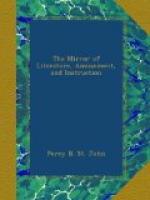General Lambert raised new works, and vigorously pushed the siege; but the besieged held out. On January 30, 1649, the King was beheaded; and the news no sooner reached Pontefract, than the royalist garrison proclaimed his son Charles ii. and made a vigorous and destructive sally against their enemies. The Parliamentarians, however, prevailed, and on March 25, 1649, the garrison being reduced from 500 or 600 to 100 men, surrendered by capitulation. Six of the principal Royalists were excepted from mercy: two escaped, but were retaken and executed at York; the third was killed in a sortie; and the three others concealing themselves among the ruins of the castle, escaped after the surrender; and two of the last lived to see the Restoration.
This third siege was the most destructive to the castle: the tremendous artillery had shattered its massive walls; and its demolition was completed by order of Parliament. Within two months after its reduction, the buildings were unroofed, and all the materials sold. Thus was this princely fortress reduced to a heap of ruins.
The Castle of Pontefract was built on an elevated rock, commanding extensive and picturesque views. The north-west prospect takes in the beautiful vale along which flows the Aire, skirted by woods and plantations. It is bounded only by the hills of Craven. The north and east prospect is more extensive, but the scenery is not equally striking and impressive. The towers of York Minster are distinctly seen, and the prospect is only bounded by the limits of vision. To the east—while the eye follows the course of the Aire towards the Humber, the fertility of the country, the spires of churches, and two considerable hills, Brayton Barf, and Hambleton Haugh, which rise in the midst of a plain, and one of which is covered with wood, increase the beauty of the scene. The south-east view includes part of the counties of Lincoln and Nottingham. To the south and south-west, the towering hills of Derbyshire, stretching towards Lancashire, form the horizon, while the foreground is a picturesque country variegated with handsome residences.
The Castle, by its situation, as well as by its structure, was rendered almost impregnable. It was not commanded by any contiguous hills, and it could only be taken by blockade.
By referring to the Engraving, the reader will better understand this defence. The outworks are there distinctly shown with the respective posts and guards: indeed, these lines exhibit a fine specimen of fortification. The quadrangular enclosure on the crest of the hill, in the lower part of the Engraving, represents Lamberts’ Fort Royal. To the right is the approach to the castle by the south gate to the barbican, crossed by a wall, with the middle gate, with the east gate at the extremity of the line. We next approach, the ballium, or castle yard through the Porter’s Lodge of two towers with a portcullis. The wall




